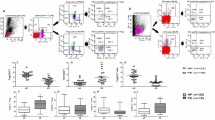Summary
The role of progesterone in the Toll-like receptor 4 (TLR4)-MyD88-dependent signaling pathway in pre-eclampsia was studied. Peripheral blood mononuclear cells (PBMCs) from pre-eclampsia (PE) patients were subjected to primary culture, and stimulated with different concentrations of progesterone (0, 10−8, 10−6, and 10−4 mol/L). The mRNA expression of TLR4, MyD88 and nuclear factor-kappaB (NF-κB) was detected by using real-time PCR. The Ikappa-B protein expression was detected by using Western blotting. The expression of tumor necrosis factor-α (TNF-α) and interleukin-6 (IL-6) in the supernatant was determined by using ELISA. With the concentrations of progesterone increasing, the mRNA expression levels of TLR4, MyD88 and NF-κB in 2−ΔΔCT value were significantly decreased, and the IkappaB protein expression levels were significantly increased. The TNF-α and IL-6 expression showed a downward trend when the progesterone concentration increased, and there were significant differences among all of the groups (P<0.05). It was suggested that progesterone can inhibit the TLR4-MyD88-dependent signaling pathway in PE significantly and benefit for the pregnancy.
Similar content being viewed by others
References
Myatt L. Role of placenta in preeclampsia. Endocrine, 2002,19(1):103–111
Kim YM, Romero R, Oh SY, et al. Toll-like receptor 4: a potential link between “danger signals”, the innate immune system, and pre-eclampsia. Am J Obstet Gynecol, 2005,193(32):921–927
Abrahams VM, Visintin I, Aldo PB, et al. A role for TLRs in the regulation of immune cell migration by first trimester trophoblast cells. Immunol, 2005, 175(12):8096–8104
Abramhen VM, Bole-aldo YM. KIM, et al. Divergent trophoblast responses to bacterial products mediated by TLRs. Immune, 2004,17(3):4286–4296
Medzhitov R, Janeway CA Jr. Decoding the patterns of self and nonself by the innate immune system. Science, 2002,296(5566):298–300
Akira S, Takeda K, Kaisho T. Toll-like receptors, critical proteins linking innate and acquired immunity. Nat Immunol, 2001,2(8):675–680
O’Neill LA. The Toll/interleukin-1 receptor domain: a molecular switch for inflammation and host defence. Biochem Soc Trans, 2000,28(5):557–563
Faure E, Equils O, Sieling PA, et al. Bacterial lipopolysaccharide activates NF-kappaB through toll-like receptor 4 (TLR-4) in cultured human dermal endothelial cells. Differential expression of TLR-4 and TLR-2 in endothelial cells. Biol Chem, 2000,275(15):11 058–11 063
Chen G, Shi J, Jin W, et al. Progesterone administration modulates TLRs/NF-kappaB signaling pathway in rat brain after cortical contusion. Ann Clin Lab Sci, 2008,38(1):65–74
Karin M, Cao Y, Greten FR, et al. NF-kappaB in cancer: from innocent bystander to major culprit. Nat Rev Cancer, 2002,2(4):301–310
Hayden MS, Ghosh S. Shared principles in NF-κB signaling. Cell, 2008,132(3):344–362
Medzhitov R, Janeway CJ. Innate immunity. N Engl J Med, 2000,343(5):338–344
Kawai T, Akira S. The role of pattern-recognition receptors in innate immunity: update on Toll-like receptors. Nat Immunol, 2010,11(5):373–384
Faas MM, Schuiling GA, Baller JF, et al. A new animal model for human preeclampsia: ultra-low-dose endotoxin infusion in pregnant rats. Am J Obstet Gynecol, 1994, 171(1):158–164
Faas MM, Broekema M, Moes H, et al. Altered monocyte function in experimental preeclampsia in the rat. Am J Obstet Gynecol, 2004,191(4):1192–1198
Xia GQ, Xu DF, Wu M, et al. Expression of Toll-like receptor 4 in neonatal cord blood mononuclear cells in patients with preeclampsia. J Huazhong Univ Sci Technol [Med Sci], 2010,30(5):615–619
Miller L, Hunt JS. Regulation of TNF-alpha production in activated mouse macrophages by progesterone. Immunol, 1998,160(10):5098–5104
Yuan Y, Shimizu I, Shen M, et al. Effects of estradiol and progesterone on the proinflammatory cytokine production by mononuclear cells from patients with chronic hepatitis C. World J Gastroenterol, 2008,4(14):2200–2207
Wang Z, Zuo G, Shi XY, et al. Progesterone administration modulates cortical TLR4/NF-κB signaling pathway after subarachnoid hemorrhage in male rats. Mediators Inflamm, 2011,2011:848309
Jones LA, Anthony JP, Henriquez FL, et al. Toll-like receptor-4-mediated macrophage activation is differentially regulated by progesterone via the glucocorticoid and progesterone receptors. Immunology, 2008,125(1):59–69
Author information
Authors and Affiliations
Corresponding author
Rights and permissions
About this article
Cite this article
Zhu, Y., Wu, M., Wu, Cy. et al. Role of progesterone in TLR4-MyD88-dependent signaling pathway in pre-eclampsia. J. Huazhong Univ. Sci. Technol. [Med. Sci.] 33, 730–734 (2013). https://doi.org/10.1007/s11596-013-1188-6
Received:
Revised:
Published:
Issue Date:
DOI: https://doi.org/10.1007/s11596-013-1188-6




